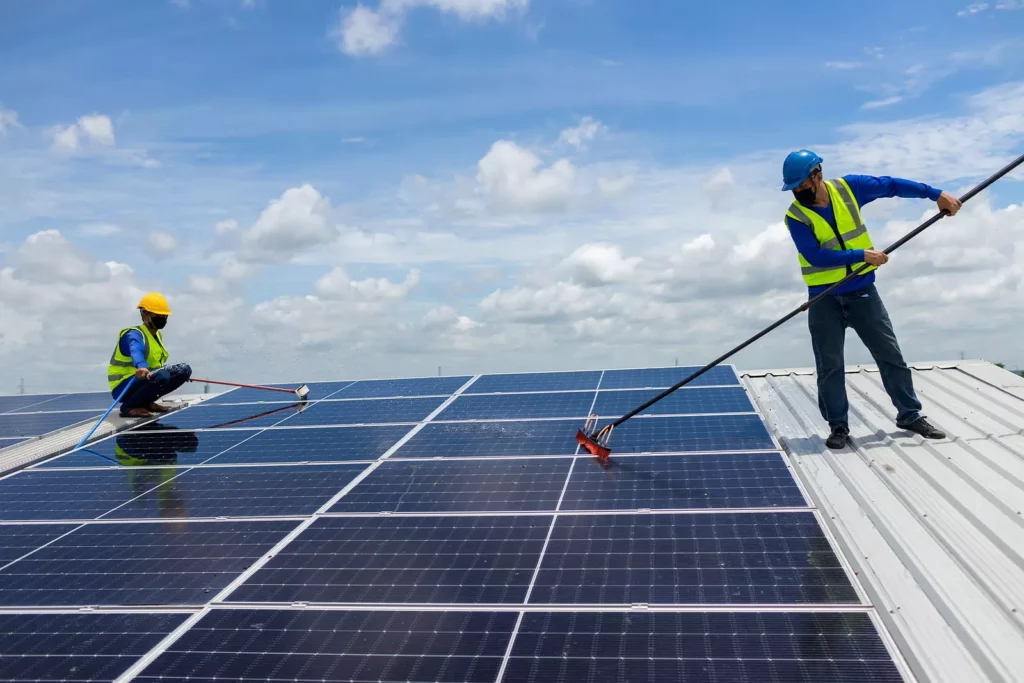The Essential Guide to Rooftop Solar Maintenance: Keeping Your Solar Panels Shining
- By user

In recent years, rooftop solar installations have become increasingly popular among businesses and homeowners, promising clean energy and reduced electricity bills. While the decision to go for rooftop solar is undoubtedly a step in the right direction for the environment and your pocket, it is crucial to understand that proper maintenance plays a key role in ensuring the longevity and efficiency of your rooftop solar plant. In this comprehensive guide, we will break down rooftop solar maintenance, making it easy to keep your rooftop solar investment shining bright.
Before we delve into the specifics, let’s cover the basics. Solar panels are designed to be low-maintenance, but regular check-ups can go a long way in preventing minor issues from turning into major headaches. Here’s a quick overview of what’s involved in maintaining your rooftop solar system:
1. Regular Visual Inspections:
Start your rooftop solar maintenance routine with a visual inspection. On a clear day, carefully climb up to your rooftop to get a closer look. Check for any signs of damage, such as cracks or physical disturbances, on the surface of the solar panels. While solar panels are durable, extreme weather conditions or accidental impacts can cause wear and tear. Additionally, inspect all the other rooftop solar system components. Inspect the wiring and connections for any signs of wear, corrosion, or loose connections. Damaged wiring can hinder the efficiency of your solar system, so addressing issues promptly is essential.
2. Monitoring System Performance:
Most modern solar installations come with monitoring systems that allow you to track the performance of your rooftop solar plant. These systems provide real-time data on energy production, making it easier to identify any irregularities. Regularly log in to your monitoring platform or app to ensure that your rooftop solar plant is producing the expected amount of solar energy. Sudden drop or prolonged decrease in energy production may indicate a malfunction that requires professional attention.
3. Cleaning Panels:
Clean solar panels are efficient solar panels. While rain may wash away some dirt, a periodic cleaning routine is still beneficial. Use a soft brush, a gentle detergent, and a hose to clean the panels. Avoid using abrasive materials or high-pressure water, as these could damage the surface. Cleaning your solar panels at least once a month helps maintain optimal efficiency.
4. Trimming Nearby Trees:
If you have trees surrounding your property, their branches could cast shadows on your rooftop solar plant, reducing its overall efficiency. Regularly trim overhanging branches to ensure that your rooftop solar plant receives maximum sunlight exposure. This not only improves energy production but also prevents potential damage from falling branches during storms.
5. Checking Inverter Lights:
The inverter is a critical component of your rooftop solar system, converting the direct current (DC) generated by your panels into usable alternating current (AC) for your home. Check the lights on the inverter regularly, as they can provide valuable insights into the system’s health. Green lights usually indicate normal operation, while red or flashing lights may signal an issue that needs attention. Refer to your inverter’s user manual for guidance on interpreting the various light indicators.
6. Going Beyond the Basics:
While the aforementioned tasks cover the essential aspects of rooftop solar maintenance, there are additional considerations for homeowners looking to maximize the lifespan and efficiency of their solar panels:
Professional Inspections:
Schedule periodic professional inspections to assess the overall health of your rooftop solar system. Certified technicians can identify potential issues that might not be apparent during routine visual inspections.
Birds and Pests:
Keep an eye out for bird nests or other pests that may choose your solar panels as their new home. Bird droppings and debris can compromise the effectiveness of your panels.
Severe Weather Precautions:
In areas prone to severe weather, such as hailstorms, it’s advisable to invest in protective measures such as hail guards. These precautions can prevent physical damage to your solar panels during extreme weather events.
Extended Warranty Coverage:
Consider extending the warranty coverage on your solar panels and inverters. While these systems are designed to last for decades, extended warranties provide an added layer of protection against unexpected issues.
Conclusion:
In conclusion, maintaining your rooftop solar plant doesn’t have to be a complex task. By incorporating these simple yet effective practices into your routine, you can ensure that your solar investment continues to shine for years to come. Regular visual inspections, monitoring system performance, cleaning panels, trimming nearby trees, checking inverter lights, and considering additional precautions will contribute to the longevity and efficiency of your rooftop solar system.
Remember, a well-maintained rooftop solar plant not only benefits the environment but also puts more savings in your pocket.
